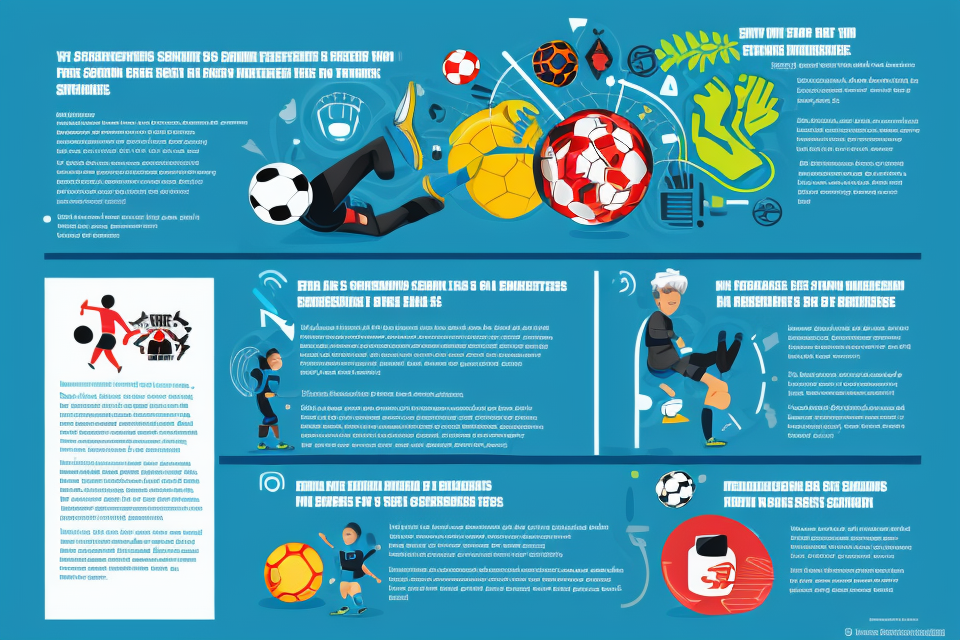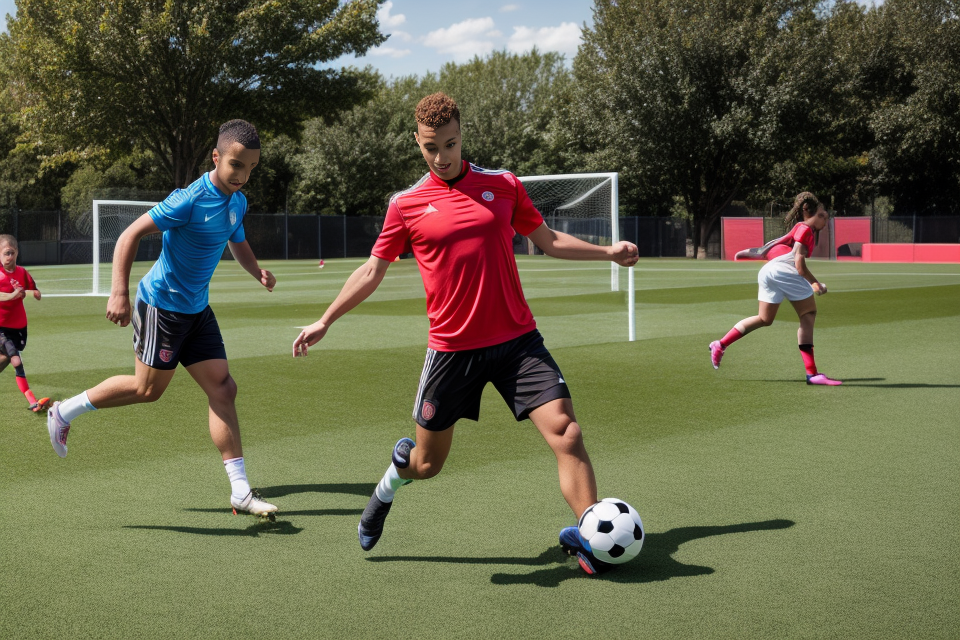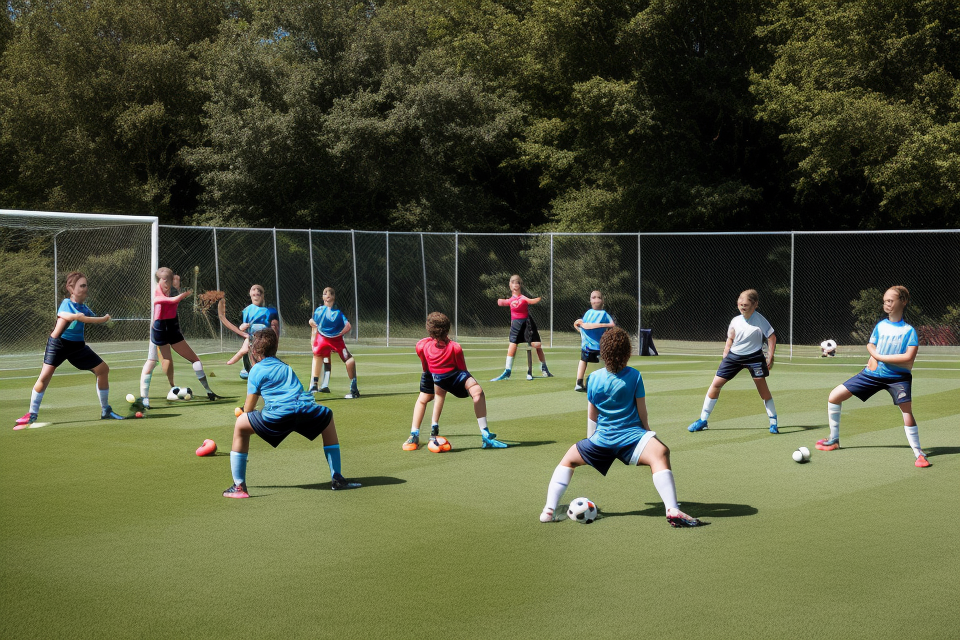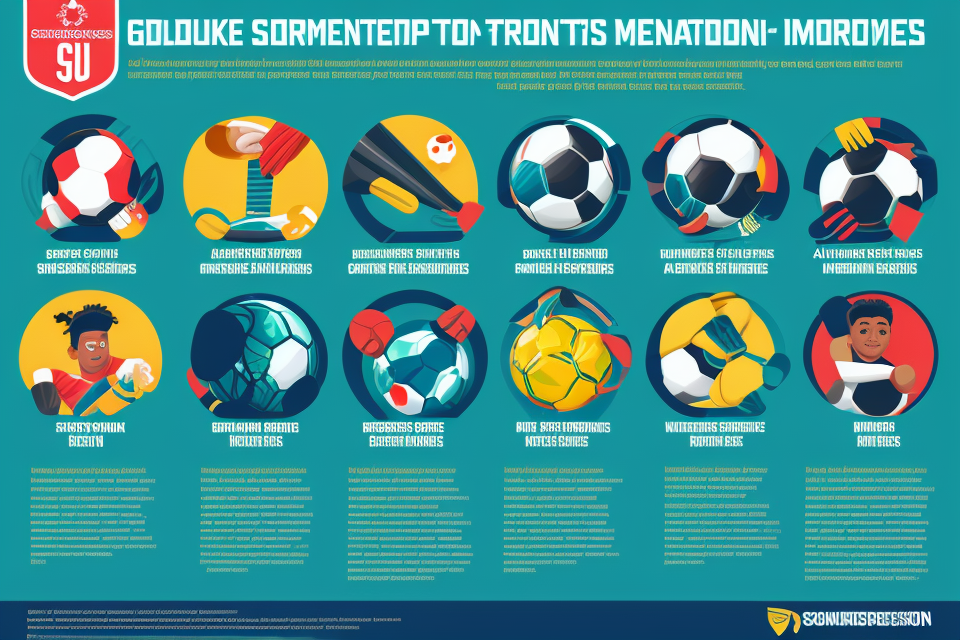Soccer is a physically demanding sport that requires speed, agility, and endurance. While it’s an exciting game to watch and play, it’s also associated with a high risk of injuries. But the good news is that there are ways to prevent soccer injuries. In this article, we’ll explore some tips and techniques that can help you stay safe on the field. From proper warm-up techniques to injury prevention exercises, we’ll cover everything you need to know to avoid common soccer injuries. So, let’s get started and learn how to play soccer safely!
Understanding Soccer Injuries
Common Types of Soccer Injuries
Soccer is a physically demanding sport that requires a high level of skill, strength, and endurance. As with any sport, injuries are an unfortunate but common occurrence. Understanding the most common types of soccer injuries can help players, coaches, and parents take proactive steps to prevent them.
Muscle Strains
Muscle strains are one of the most common injuries in soccer. They occur when a muscle is stretched beyond its capacity, causing microscopic tears in the muscle fibers. This can happen when a player suddenly changes direction or accelerates at high speed. Muscle strains can range from mild to severe, and treatment may involve rest, ice, compression, and elevation.
Ligament Sprains
Ligament sprains are another common injury in soccer. Ligaments are the tough, fibrous bands of tissue that connect bones to each other. When a ligament is stretched or torn, it can cause pain, swelling, and instability in the joint. Ankle sprains are particularly common in soccer, but knee ligament injuries can also occur. Treatment for ligament sprains may involve rest, ice, compression, elevation, and physical therapy.
Concussions
Concussions are a type of traumatic brain injury that can occur in soccer when a player is hit in the head or collides with another player. Symptoms of a concussion may include headache, dizziness, confusion, and memory loss. If a player suspects that they have suffered a concussion, they should immediately notify their coach and seek medical attention.
Ankle Sprains
Ankle sprains are a common injury in soccer, particularly when a player lands awkwardly or twists their ankle. Ankle sprains can range from mild to severe, and treatment may involve rest, ice, compression, elevation, and physical therapy.
Knee Injuries
Knee injuries are another common injury in soccer, particularly among players who are not properly trained or who do not wear appropriate protective gear. Knee injuries can range from mild sprains to more severe injuries such as ACL tears. Treatment for knee injuries may involve rest, ice, compression, elevation, physical therapy, and in some cases, surgery.
Preventing these common types of soccer injuries requires a multi-faceted approach that includes proper training, conditioning, and equipment. By taking proactive steps to prevent injuries, players can stay healthy and continue to enjoy the game they love.
Factors Contributing to Soccer Injuries
Soccer is a physically demanding sport that requires a high level of skill, strength, and endurance. Unfortunately, it is also a sport that is associated with a high risk of injury. In order to prevent soccer injuries, it is important to understand the factors that contribute to them.
One of the primary factors contributing to soccer injuries is poor technique. Players who do not have proper technique are more likely to make mistakes, which can lead to collisions and other types of accidents on the field. Poor technique can also lead to overuse injuries, such as tendinitis or stress fractures, which can be difficult to recover from.
Another factor that can contribute to soccer injuries is a lack of proper equipment. Players should always wear appropriate shoes that provide adequate support and protection for their feet and ankles. They should also wear shin guards to protect their legs from injury, and a mouthguard to protect their teeth. In addition, players should make sure that their uniforms fit properly and do not impede their movement on the field.
Insufficient warm-up and cool-down can also contribute to soccer injuries. Before starting a game or practice, players should take the time to stretch and warm up their muscles. This will help to prevent injuries by increasing blood flow to the muscles and preparing them for physical activity. After a game or practice, players should also take the time to cool down and stretch, which will help to prevent stiffness and soreness.
Overuse is another common factor that can contribute to soccer injuries. Players who train too much or play too many games in a short period of time can put too much stress on their muscles, tendons, and other tissues. This can lead to overuse injuries, such as tendinitis or stress fractures, which can be difficult to recover from.
Finally, poor field conditions can also contribute to soccer injuries. Players should make sure that they are playing on a safe and well-maintained field. The field should be free of debris and obstacles, and the turf should be even and well-groomed. If the field is not safe, players should speak to their coach or team manager about having it inspected and repaired.
By understanding the factors that contribute to soccer injuries, players can take steps to prevent them. By using proper technique, wearing appropriate equipment, warming up and cooling down properly, avoiding overuse, and playing on safe fields, players can reduce their risk of injury and stay healthy throughout the season.
Pre-Season Preparation
Importance of Proper Equipment
When it comes to preventing soccer injuries, one of the most important things you can do is to ensure that you have the proper equipment. In addition to protecting you from injury, the right gear can also improve your performance on the field. Here are some essential pieces of equipment that every soccer player should have:
- Appropriate shoes: The right shoes can make a big difference in how you perform on the field. Look for shoes that fit well and provide good support for your feet.
- Shinguards: Shinguards are a must-have for any soccer player. They help protect your shins from impact and can prevent serious injuries such as fractures.
- Mouthguard: A mouthguard is an essential piece of equipment for any contact sport, including soccer. It can help protect your teeth and mouth from injury, especially if you’re playing in a competitive game.
- Headgear: While headgear is not mandatory in soccer, it can be a good idea to wear it if you’re playing in a rough game or if you’re concerned about head injuries. Look for headgear that fits well and is comfortable to wear.
Overall, investing in the right equipment is an important step in preventing soccer injuries. By taking the time to choose the right shoes, shinguards, mouthguard, and headgear, you can help ensure that you stay safe and healthy on the field.
Injury Prevention Through Warm-Up and Cool-Down Exercises
In soccer, injury prevention is a critical aspect of maintaining player health and fitness. Warm-up and cool-down exercises are essential components of injury prevention. They help to prepare the body for physical activity and to reduce the risk of injury. In this section, we will discuss the different types of warm-up and cool-down exercises that can be used to prevent soccer injuries.
Dynamic stretching
Dynamic stretching is a type of stretching that involves movement. It is a great way to prepare the body for physical activity by increasing blood flow and mobility. Dynamic stretching exercises for soccer players include jogging, high knees, and leg swings. These exercises should be performed for 5-10 minutes before the start of the game or practice.
Strengthening exercises
Strengthening exercises are important for injury prevention in soccer because they help to build muscular strength and endurance. Exercises such as squats, lunges, and calf raises can help to strengthen the legs, which are the most commonly injured part of the body in soccer. Strengthening exercises should be performed 2-3 times per week, with a minimum of 3 sets of 8-12 repetitions for each exercise.
Flexibility exercises
Flexibility exercises are essential for injury prevention in soccer because they help to improve range of motion and reduce the risk of muscle strains and tears. Exercises such as hamstring stretches, quad stretches, and calf stretches can help to improve flexibility in the legs. Flexibility exercises should be performed daily, with each stretch held for 15-30 seconds.
In conclusion, warm-up and cool-down exercises are crucial for injury prevention in soccer. Dynamic stretching, strengthening exercises, and flexibility exercises are all effective ways to prepare the body for physical activity and reduce the risk of injury. By incorporating these exercises into their pre-season preparation, soccer players can enjoy a safe and healthy season.
Building Endurance and Conditioning
Soccer is a sport that requires high levels of endurance and conditioning. To prevent injuries during the season, it is important to begin the pre-season with a comprehensive conditioning program. The following are some of the best techniques for building endurance and conditioning in soccer players:
- Interval training: Interval training involves alternating periods of high-intensity exercise with periods of rest or low-intensity exercise. This type of training is effective for building endurance and improving cardiovascular fitness. For example, a soccer player might run at full speed for 30 seconds, then jog for 90 seconds before repeating the cycle.
- Aerobic exercises: Aerobic exercises, such as running, cycling, or swimming, are great for building endurance and improving cardiovascular fitness. These exercises should be performed at a moderate to high intensity level for at least 20-30 minutes per session, several times per week.
- Plyometrics: Plyometrics are explosive exercises that involve jumping, bounding, or hopping. These exercises are great for building power and explosiveness in the legs, which is essential for soccer players. Examples of plyometric exercises include box jumps, squat jumps, and depth jumps.
By incorporating these techniques into a comprehensive conditioning program, soccer players can improve their endurance and reduce their risk of injury during the season. It is important to remember that the pre-season is the perfect time to focus on building a strong foundation of endurance and conditioning, which will carry players through the rigors of the season.
During the Game
Hydration and Nutrition
Proper Hydration
During soccer games, it is important to maintain proper hydration levels to prevent dehydration, which can lead to fatigue, cramps, and other injuries. Here are some tips for proper hydration:
- Drink water before, during, and after the game
- Avoid drinks high in sugar and caffeine
- Take breaks to rest and rehydrate
Energy-Rich Snacks
Eating energy-rich snacks during the game can help maintain energy levels and prevent low blood sugar, which can lead to dizziness and fatigue. Here are some examples of energy-rich snacks:
- Fruits such as bananas and oranges
- Energy bars
- Granola or trail mix
- Peanut butter or hummus on whole-grain crackers
It is important to note that snacking during the game should be limited to prevent interference with the digestive system and cause stomach cramps.
By following these tips, soccer players can maintain optimal energy levels and prevent injuries during the game.
Proper Technique and Form
- Correct kicking and striking technique: Kicking and striking the ball is a crucial aspect of soccer. Players should focus on using the instep or inside of the foot to strike the ball with power and accuracy. Improper technique can lead to injuries such as shin splints, plantar fasciitis, and even stress fractures.
- Proper throwing and catching technique: Throwing and catching the ball is also an important part of soccer. Players should use the correct grip on the ball and follow through with their throwing arm to ensure accuracy and prevent injuries. Improper technique can lead to elbow, shoulder, and wrist injuries.
- Safe tackling and blocking technique: Tackling and blocking are essential for defending in soccer. Players should use proper technique to tackle by hitting the ball away from the opponent and not the opponent themselves. Blocking should be done by using the chest or foot to block the ball, rather than using the head or arms which can lead to head and neck injuries. Improper tackling and blocking technique can result in injuries such as sprains, strains, and even concussions.
Communication and Collaboration
Communication and collaboration are essential aspects of preventing soccer injuries during a game. By working together and keeping open lines of communication, players can avoid accidents and reduce the risk of injury. Here are some tips on how to effectively communicate and collaborate with teammates:
Calling for Help When Injured
If a player is injured during a game, it is crucial to call for help as soon as possible. Players should yell for a substitute or the team’s coach to request assistance. This prompt action can prevent further injury and ensure that the player receives proper medical attention.
Communicating with Teammates about Potential Hazards on the Field
Players should communicate with their teammates about potential hazards on the field, such as slippery surfaces, wet spots, or uneven terrain. By alerting their teammates to these hazards, players can avoid accidents and reduce the risk of injury. Players should also be aware of their surroundings and keep an eye out for any potential hazards that may affect their teammates.
In addition to communication, collaboration is also crucial in preventing soccer injuries. Players should work together to maintain proper field conditions, ensure that everyone is aware of the rules, and follow safety guidelines. By collaborating and working together, players can create a safer environment for themselves and their teammates.
Post-Game Recovery
Cool-Down and Stretching
Cooling down and stretching after a soccer game is an essential part of post-game recovery. It helps to reduce muscle soreness, prevent injury, and improve flexibility. Here are some tips for effective cool-down and stretching:
- Light jogging: After the game, take a light jog around the field to gradually slow down your heart rate and reduce your body temperature. This helps to prevent injury and reduce muscle soreness.
- Gentle stretching: Once you have finished jogging, find a quiet spot on the field and begin gentle stretching. Focus on the major muscle groups used during the game, such as the hamstrings, quadriceps, calves, and groin. Hold each stretch for 15-30 seconds and repeat 2-3 times. Be sure to breathe deeply and slowly while stretching to help relax your muscles.
In addition to cool-down and stretching, it is also important to hydrate and refuel after a game. Drinking plenty of water and consuming a balanced meal or snack can help to replenish energy stores and support muscle recovery.
Treating Minor Injuries
In soccer, injuries are an unfortunate but common occurrence. While some injuries may require medical attention, there are several minor injuries that can be treated at home. The RICE method is a simple and effective way to treat minor injuries.
Rest: The first step in treating any injury is to rest the affected area. This means avoiding any activities that may cause pain or discomfort. If you have sprained your ankle, avoid running or playing soccer until the pain has subsided.
Ice: Applying ice to the affected area can help reduce swelling and pain. Use a cold pack or a bag of frozen vegetables wrapped in a clean cloth. Apply ice for 15-20 minutes at a time, several times a day.
Compression: Compression can help reduce swelling and support the affected area. Use an elastic bandage or compression wrap to apply even pressure to the area. Start at the ends of the affected area and work your way up to the top.
Elevation: Elevating the affected area can also help reduce swelling. Sit or lie down with your feet elevated above the level of your heart. This can help reduce pain and discomfort and promote healing.
It is important to note that while the RICE method can be effective in treating minor injuries, it is not a substitute for medical attention. If you experience severe pain, swelling, or difficulty moving, seek medical attention immediately. Additionally, if you continue to experience pain or discomfort after several days of treatment, it is important to seek medical attention to rule out any serious injuries.
Addressing Persistent Pain or Injury
Addressing persistent pain or injury is a crucial aspect of post-game recovery in soccer. Ignoring persistent pain or injury can lead to worsening of the condition and prolonged recovery time. Therefore, it is essential to address the issue promptly and take appropriate measures to ensure a safe and speedy recovery.
Here are some tips on how to address persistent pain or injury:
- Consulting a medical professional
It is always recommended to consult a medical professional when dealing with persistent pain or injury. A sports medicine specialist or a physiotherapist can evaluate the injury and provide a customized treatment plan. They can also guide on the appropriate exercises and activities that can be resumed, and those that should be avoided.
- Adjusting training regimen
If you have been experiencing persistent pain or injury, it is important to adjust your training regimen. Reduce the intensity and duration of training and avoid activities that aggravate the pain. Focus on strengthening exercises that target the affected area and improve overall fitness.
- Proper rest and recovery
Rest and recovery are crucial for healing and preventing further injury. Allow the affected area to recover fully before resuming strenuous activities. Apply ice to reduce swelling and inflammation, and use compression to support the affected area. Elevate the limb to reduce pain and promote healing.
By following these tips, you can effectively address persistent pain or injury and ensure a safe and speedy recovery. Remember, addressing the issue promptly can prevent worsening of the condition and prolonged recovery time.
FAQs
1. What are the most common soccer injuries?
The most common soccer injuries include muscle strains, sprains, and concussions. These injuries can occur due to a lack of proper warm-up, inadequate training, or improper techniques.
2. How can I prevent soccer injuries?
To prevent soccer injuries, it is important to properly warm up before each game or practice, stay hydrated, and maintain good nutrition. Additionally, wearing appropriate protective gear, such as shin guards, can help reduce the risk of injury.
3. What is the best way to warm up before a soccer game?
The best way to warm up before a soccer game is to engage in light aerobic activity, such as jogging or cycling, to get the blood flowing to the muscles. This can be followed by dynamic stretching exercises, such as lunges or leg swings, to increase flexibility and reduce the risk of injury.
4. How can I prevent concussions while playing soccer?
To prevent concussions while playing soccer, it is important to wear proper protective gear, such as a helmet or headgear, and to avoid heading the ball without proper technique. Additionally, players should be aware of their surroundings on the field and avoid collisions with other players or objects.
5. Is it safe to continue playing soccer after suffering an injury?
It is not safe to continue playing soccer after suffering an injury. If you experience any pain or discomfort during a game or practice, it is important to stop playing and seek medical attention. Continuing to play with an injury can worsen the condition and lead to long-term damage.



